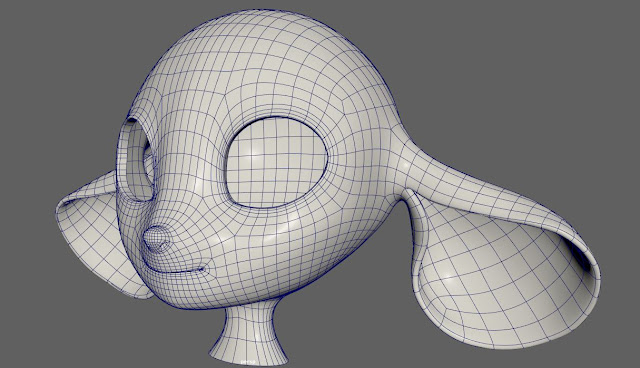Mistake #1
Too Many Subdivisions, Too Early
Solution:
While the industry standard for model resolutions has gotten higher throughout the years, it’s important to remember to start low. Often times you can make the same shapes with less polygons. But at the same time, don’t let this scare you into not adding more topology as you progress. When you need more edge loops, you need more edge loops. The key is just to start low and slowly add more as needed.

Mistake #2
Messy Topology and Bumpy Surfaces
It’s easy to get caught up in the forms and ignore the topology. Just remember that every once in awhile it’s important to clean things up.
Solution:
- Make sure there aren’t any stray vertices that are breaking the flow of the edge loops.
- Try to keep edge loops evenly spaced and quads as square as possible.
- Look at your model from all angles to find little bumps in the surface that need smoothed out.
Mistake #3
Triangles and Ngons
One of the first things you learn in the character program at AnimSchool is: quads good, triangles and ngons bad.
But what are triangles and ngons?
An ngon is a face or polygon that is made up of five or more edges connected by five or more vertices. Anything over a quad (4 sides) is considered an ngon. And of course, a triangle is a polygon with 3 sides.
Why are these so bad you ask?
There are several issues that they can cause but the biggest is that they can create odd and unwanted deformations when rigged to be animated. If a rigger finds tris or ngons in your model, it will immediately be sent back to you to fix them. They can also cause issues further down the pipeline when smoothing and rendering.
Solution:
Quads, however, are universal and generally play nicely with all aspects of the animation pipeline.
Mistake #4
Incorrect Proportions
Proportions are one of the most crucial things to get right in 3D modeling. Get them wrong, and it will throw off your entire model. You have to train your eyes to make comparisons and estimate depth. Of course, allowances can be made for style, and in the end, if you are working off of concept art, certain exaggerations would have to be allowed.
Solution:
- Break the model down to the most basic shapes, that way you can easily adjust them according to the concept art.
- If you have multiple views of your object, then the use of image planes in orthographic views become very useful in judging proportion. However, try not to spend too much time in the orthographic views because it’s more important that it looks right with perspective.
- Another trick is to open the concept art in an image viewer program (outside of Maya), line up the concept and model so that they are directly on top of each other (same size and angle), and then quickly flash back and forth between them. This can help you notice more differences in your model to more closely match the concept art.
Mistake #5
Worrying Too Much, or Too Little About Topology
Modeling (like most things in the animation industry) is a balancing act between the technical and creative aspects. They are equally important for both appeal as well as functionality. It’s easy to get hung up on one or the other for too long.
Solution:
One of the best ways to approach it is to think artistically and focus on the forms for awhile, then give yourself a break by just going through and doing a little clean up. In the end, what really matters is how closely the 3D model looks to the original concept art. Just remember to always keep the topology in mind while you are interpreting the art.
For more animation training at one of the top online animation schools, please join us at www.animschool.com









Leave a Reply